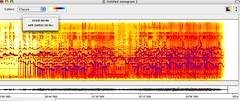What MP3 conversion does to your music
A few years back, I think it was generally well known that MP3 conversion compressed music in a particular way. That it was listenable, no doubt; that the file sizes are 1/10th the size, no doubt again. But as to whether it is "as good as" or a replacement for your standard audio CD, urk, think again.
And yet, these days it's very common to hear people boast that they've sold their entire CD collection, and keep everything in MP3 format on their hard drives and/or iPods. Far from demanding better quality for themselves, people are accepting a downgraded form of music. Which is like, I dunno, being happy to live with a snowy/fuzzy tv picture, or preferring a 3rd generation VHS copy of a film to the original.

Above, there's a sonogram of the Joan Baez version of "Let it Be". I've clicked in the higher frequency band of the song, near the beginning, and we're informed that where I clicked, it's either 20,219.94Hz (20.22kHz), or 19,912.13Hz, which I guess is the nearest whole note, or something.
In other words, we've got a frequency which is right in the upper range of human hearing (which ranges in a band from 20Hz to 20KHz), about what you'd expect from the sometimes shrill Ms Baez.
Anyway.

Above, there's a second sonogram of the same song, encoded (in iTunes) as a 128kbps MP3 file. Click in approximately the same spot, and the high frequency band tops out at 15,147.84 Hz. in other words, we've lost, ooh, 5,072Hz somewhere.
Important? I'd say so. You're certainly missing a huge chunk of auditory information, part of what makes a recording sound more like a natural sound. Some people will claim they can't hear the difference. I'd say that you might not consciously notice, but over extended listening periods, the difference will be clear.
And yet, these days it's very common to hear people boast that they've sold their entire CD collection, and keep everything in MP3 format on their hard drives and/or iPods. Far from demanding better quality for themselves, people are accepting a downgraded form of music. Which is like, I dunno, being happy to live with a snowy/fuzzy tv picture, or preferring a 3rd generation VHS copy of a film to the original.

Above, there's a sonogram of the Joan Baez version of "Let it Be". I've clicked in the higher frequency band of the song, near the beginning, and we're informed that where I clicked, it's either 20,219.94Hz (20.22kHz), or 19,912.13Hz, which I guess is the nearest whole note, or something.
In other words, we've got a frequency which is right in the upper range of human hearing (which ranges in a band from 20Hz to 20KHz), about what you'd expect from the sometimes shrill Ms Baez.
Anyway.

Above, there's a second sonogram of the same song, encoded (in iTunes) as a 128kbps MP3 file. Click in approximately the same spot, and the high frequency band tops out at 15,147.84 Hz. in other words, we've lost, ooh, 5,072Hz somewhere.
Important? I'd say so. You're certainly missing a huge chunk of auditory information, part of what makes a recording sound more like a natural sound. Some people will claim they can't hear the difference. I'd say that you might not consciously notice, but over extended listening periods, the difference will be clear.

2 Comments:
entropy wears many disguises. i expect we used to hear better too, as a species, before loud noises were invented.
By roy, at 6:27 am
roy, at 6:27 am
I'm with you on this: as much as I would like an MP3 player for the convenience of listening to my music collection elsewhere than at home, I see no reason to degrade the music I love to the frankly somewhat tinny reproduction possible via MP3 compression.
By Lisa Rullsenberg, at 3:10 am
Lisa Rullsenberg, at 3:10 am
Post a Comment
<< Home